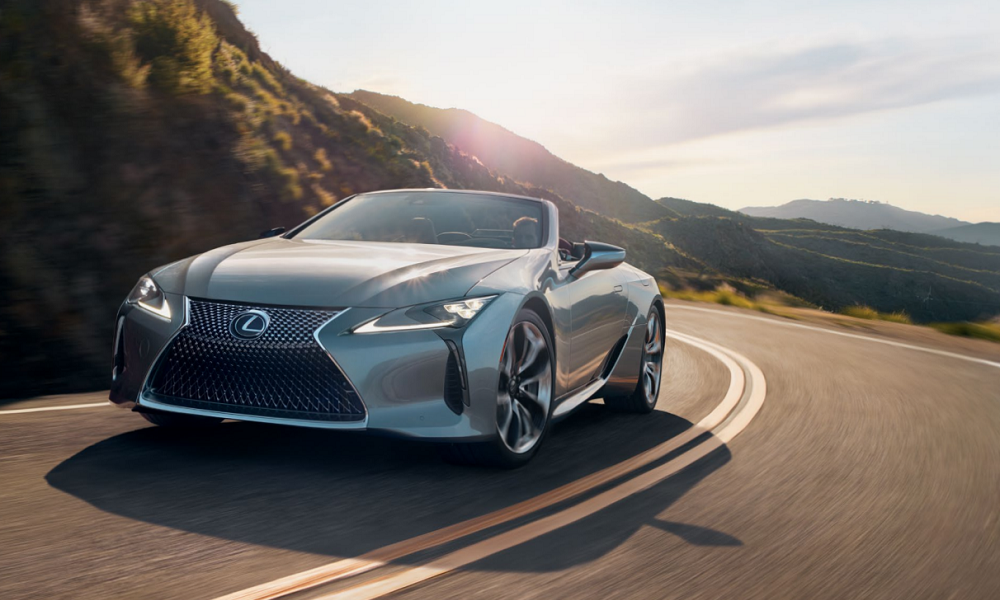Lexus LC History: Creating a Halo Grand Tourer
Seven years after the SC’s farewell, Lexus reinvigorates their grand tourer with historical inspirations and lessons learned from the LFA.
The LFA provided Lexus with valuable lessons on creating something truly unique. Handbuilt, fast, and handsome, it was a desirable, albeit very expensive, luxury exotic, even by Lexus’s standards. And while we’ve extensively covered the LFA’s history in particular, the story of the original concept car titled the LF-LC didn’t end there. Rather, in addition to the sharper, more angular supercar LFA, Lexus continued refining their grand tourer concept separately. This required an entirely different philosophy, one more in line with their original grand tourer, the SC. This wasn’t intended as a limited-production, hand-built vehicle, but rather a well-rounded full-size 2-door coupe. And much like other Lexus vehicles, the Lexus LC also features a deceptively storied history.
Defining the Grand Tourer
The Bugatti Typr 57 and its contemporaries marked the absolute pinnacle of touring in their day. Photo by: bugatti.com
Before we get into the Lexus LC, first we need to establish a clear definition and starting point of its body style. The term “Grand Tourer” comes from the Italian gran turismo. Broadly, the classification defines a vehicle intended for high speeds over long distances. Traditionally, though not always, these cars are front-engine, rear-drive in either 2-seater or 2+2 configuration. Most of these cars are coupes, though convertibles, shooting-brakes, and even wagon grand tourers exist. The origins date back to the pre-Depression days when long-distance bespoke gentleman’s cars adorned the stables of royalty and business moguls. Though the days of classic Bugattis, Auburns, Duesenbergs, and more thoroughly ended with the Depression, the grand tourer experienced a great resurgence following World War II.
Pictured: Aston Martin DB4 GT Zagato, Jaguar Series 1 E-Type, Maserati 3500 GT. Photos from: Wikimedia Commons
By the latter half of the century, dozens of manufacturers and a wide variety of body styles laid claim to the GT designation. You had everything from slim sports cars like the Alfa GTA and MGB GT to the commanding Jensen Interceptor and the utterly captivating Jaguar E-Type. From Maserati 3500GTs to Porsche 911s, these cars decorated freshly-paved international roads throughout the world. Many of these vehicles suffered massive slumps in sales following the 1973 Oil Crisis, only making a full return to form in the 1990s. Japan heavily capitalized here, releasing a plethora of vehicles like the Nissan Skyline GT-R, Toyota A80 Supra, Mazda FD3S RX-7, and as we’ll discuss, the Toyota Soarer / Lexus SC.
The First Japanese Grand Tourers
Up until the 1960s, Japan wasn’t particularly renowned as a nation with a strong international presence, certainly not with sleek sports cars. But an ever-increasing interest in these hot, fast coupes drove demand ever-higher for something indigneous. By the middle of the decade, almost every manufacturer experimented with various designs, each of them radical in their own way. From the hand-built, lightweight, sporty Nissan Silvia to the wildly innovative rotary Mazda Cosmo, these designs evolved into some of the most famous racing vehicles in international circles. And among the finest of these vehicles was Toyota’s 2000GT, considered the first true Japanese grand tourer.
Most of the design work on the 2000GT’s owed to Yamaha, who even provided the wood dashboard using select pieces reserved for their grand pianos. Photo by: Toyota USA
The 2000GT, styled by Satorou Nozaki and Jiro Kono, followed in the footsteps of some of the most objectively gorgeous vehicles of all time. The designers drew direct inspiration from the likes of the Jaguar E-Type, Mercedes Gullwing, and Ferrari GTO race cars. It features a prominent, sleek hood hiding a potent DOHC straight-six, the lines flowing into a svelte fastback design. Between 1967 to 1970, Toyota hand-built 337 production road cars, every one of them spoken for practically before they had the wheels mounted. And much like the other 1960s Japanese racing legends, the 2000GT cemented Japan in the international grand touring marketplace. By 1970, the car raced both indigenously and in the US, headed by none other than Carroll Shelby.
Filling the 2000GT’s Shoes
The handbuilt 2000GT and Century, as well as the mass-produced Crown and Corona Mark II, carried reputations of opulence without sacrificing reliability. Even the sporty Corollas and Sprinters made headway overseas. So much so that by 1980, demand for a new Japanese grand-tourer spurred Toyota to answer again. Debuting at the 1980 Osaka Auto Show as the EX-8, the Soarer hit showrooms the following year to glowing reception.
Awarded Japan’s Car of the Year, it represented the spiritual successor to the 2000GT in the sense that it marked a return to a vehicle intended for driving long-distance with speed and comfort. To this end, the Soarer sported the traditional Toyota boxy styling of the 1980s, but with a very familiar silhouette. A long hood presented a narrow, squared-off grille with subtle chrome. Small louvered rear window hinted at a 2+2 arrangement. And the stubby trunk housed enough room for the essentials.
The original Soarer shared the same platform as the 2nd-generation Supra. Photo by: Matthew Malek (Link in Japanese only)
The Soarer retained this silhouette for virtually its entire production run. Its second-generation strikingly resembled the first as well. But when the first hints of Lexus sprouted in the minds of executives, they figured there’d be no car more appropriate to suit a new luxury marque than a grand tourer. Thus, following the success of the 1989 LS, Toyota decided to double down and release the Soarer in the US for the first time. This change actually suited Toyota greatly, as the Soarer was heavily taxed in Japan due to its size and engine displacement. Therefore, this new model, the Lexus SC, effectively saved the Soarer model from an early end.
The SC Philosophy
Lexus debuted the SC for the 1992 model year to widespread critical acclaim. Some news outlets referred to the Calty Design Research-penned SC as the best-looking grand tourer of the 1990s. Penned in California, Lexus intended the car from Day 1 as an enthusiast’s luxury coupe, in a similar vein to the 2000GT of old (though far more accessible). The car enjoyed wide-open roads and freeways, staples of American and mainland European road networks. Its rounded appearance still retained the classic long hood, 2-door, short trunk look. And though large for Japan’s roads, it found popularity overseas, enough to see its production until 2000.
A small number of third-generation Soarers served as Japanese police interceptors, equipped with a 1JZ-GTE and 5-speed manual transmission.
By this point, however, coupes started shifting gears away from mainstream car culture. It wouldn’t be until the late-2000s that luxury car companies such as Maserati and Jaguar returned to building the body style. Lexus’s bread and butter, meanwhile, remained its RX crossover. But Lexus wasn’t done with this body style by a long shot.
By the third-generation SC, Lexus saw the writing on the wall and ultimately the SC name folded. But not before leaving a successor following in its philosophy. While the later SC models arguably targeted a more widespread audience, the LF-LC concept fit a different mold. The LF nameplate spawned two distinct models, one of which was the LFA, based on the LF-A concept. But the LFA, even by Lexus’s standards, was an ambitious design, ultimately out-of-reach to most. Lexus needed a new halo car, and thanks to a resurgence in the luxury coupe in the mid-2010s, the LF-LC happily obliged.
The last gasp of the SC430 took place in the 2013 SuperGT season, where the car won its final race at Twin Ring Motegi on November 3.
Remaking the Gentleman Enthusiast’s Car
Harkening back to the original philosophy of the likes of the 2000GT, this new LC, or “Luxury Coupe,” represented Lexus’s share of the newly reborn grand-tourer market. Work began on the concept almost immediately after the discontinuation of the SC nameplate. Capitalizing on the trends set by the likes of the Maserati Granturismo, Audi RS line, and C6 Corvette, Lexus fully anticipated a production version of the concept almost as soon as it hit the main floor of 2012’s North American International Auto Show. In short order, Lexus confirmed the public’s suspicions, and by March 2017 the LC was in production. Lexus altered almost nothing between the concept and final design, given how well-received the concept was in the first place.
Photo by: Wikimedia Commons
The design incorporated the trademark Lexus grille with an all-new flowing 2-door design. Calty reprised its role as lead designer with a concept reminiscent of the LFA but more rounded like its SC parent. Effectively, the LC combined elements of various portions of its heritage going all the way back to the 2000GT.
2000GT photo by: GQ Japan
The 2000GT’s influence resonates remarkably strongly in the subtleties of the LC’s design. Examples include the upswept triangular side window glass, or the downturned decklid ending in a subtle upwards-swept curve like the end of a calligrapher’s pen stroke. More obviously, the vehicle marks the first return to a true fastback grand tourer configuration since the 2000GT. Coupled with the SC’s rounded lines and the LFA’s sharp, exotic character, the exterior design features a remarkably diverse set of inspirations. Even the SC430’s design elements return with the reveal of the convertible at the 2019 LA Auto Show.
Under the Long Hood
Of course, design is only one (rather important, granted) component of any grand tourer. All truly great designs of this type, however, know that beauty isn’t skin-deep. Dating back to the original Soarers, Toyota and subsequently Lexus never really compromised on the powertrain, even for Japan’s taxations. First-gen SCs came with a choice of the 2JZ-GE or 1UZ-FE V8, in addition to the 1JZ-GTE in the Soarer. Although automatics provided the majority of sales, a manual was also available for earlier models. To continue the trend of high-quality power, Lexus once again valued performance and overbuilt engineering for their new flagship model.
In the LC, you have 2 main powerplant options. The 2UR-GSE motivates the LC 500, a 5.0L V8 producing 471 BHP, developed from the URL10 from the GS F. Behind it sits a 10-speed Aisin paddle-shifter automatic gearbox, providing both refinement and control. The second option’s more modest, though also no slouch. A 3.5L 8GR-FKS and 2NM A/C electric motor power the LC 500h hybrid. While the horsepower is a more modest 354 combined, it has the torque advantage as well as also having a 10-speed automatic. For everyday use, therefore, it’s certainly debatable but ultimately personal preference as to which strikes your fancy.
The LC Today
Grand tourers in general remain a niche market for a discerning enthusiast of means. As such, the LC showed modest sales figures compared to other models. Furthermore, Lexus canceled their planned LC F performance coupe, which would’ve sported a twin-turbo powerplant at over 660 horsepower. As such, the future of the LC model’s largely ambiguous as of 2022. Although the model continues captivating customers with its looks and powertrain, so too did the grand tourers of old. And while more accessible models like the Jaguar E-Type continued production well beyond a decade, they also existed at a point when the body style was far more in vogue. Today, the wind blows far more favorably to the compact market, with large-engined coupes no longer meeting sales quotas.
Though this dip occurred in the past as well, especially during the Oil Crisis. And following the Malaise Era, the grand tourer bounced back again, suitably updated without compromising its principles. Much like those cars of the 50s and 60s, the LC continues this philosophy of providing a ride that’s both elegant and performance-oriented. The grand tourer’s seen a great deal of trying times lately. However, even if the LC only lives for one or two more generations, the desire for such a car’s not going away anytime soon.


















